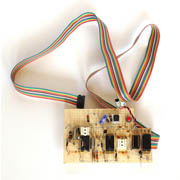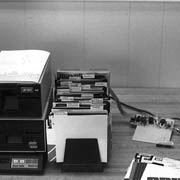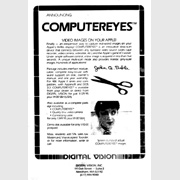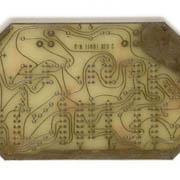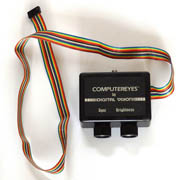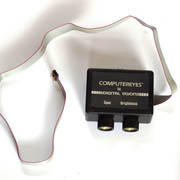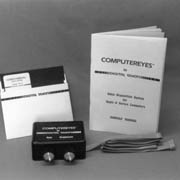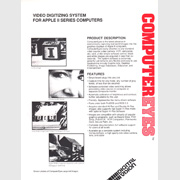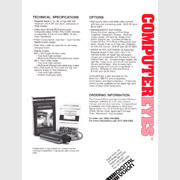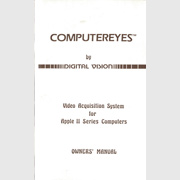

|
products |
|
|||
|
ComputerEyes Digital Vision's very first product. Developed in Dave & Vi's spare bedroom (see Inception) for the Apple II computer. The prototype was made on a perforated breadboard using component sockets connected together with wire-wrap. For production, a printed circuit board was laid out using a hand-taping method. ComputerEyes was a slow-scan video capture device and took several seconds to complete a scan. Instead of capturing the entire image in one video field (1/60 second), samples were taken one per scan line, so that only one column of pixels was captured each field, starting on the left. Then the sample point was shifted a little to the right and another column was captured. This continued from left to right until the entire image had been scanned. So to capture an image that was 320 pixels wide (the Apple's display resolution) required nearly six (320 x 1/60) seconds. This meant that the subject in front of the video camera had to be relatively stationary, or a paused VCR had to be used as the video source. This approach allowed a small number of inexpensive components to be used in the design, making the product affordable to the masses. Putting the burden of the task on the software, tightly-coded machine language software was written to detect the video vertical and horizontal sync, cause samples to be taken, read them into the computer, and store them away in the Apple II's graphics memory. Even though it was a slow-scan capture device, it was all an Apple II could do to keep up with the task! The original ComputerEyes captured strictly black-and-white images — no shades of gray (and certainly no color!). There was a Brightness knob that controlled the threshold, so that parts of the image would be white and others black. Before it went into production, the design was enhanced so that eight shades of gray could be captured by performing eight successive scans at different threshold levels (yes, it took 48 seconds!). But this resulted in a better image than the Apple II could even display. That is, until later generations of computers (and ComputerEyes) came along .................
|
|||||
